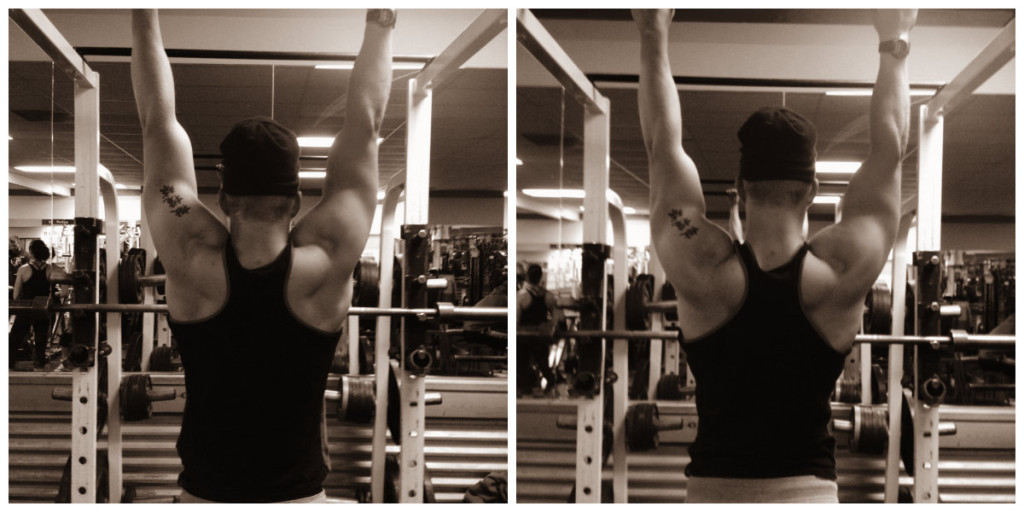Master Pull-Ups: Eight Tips To Pulling Prowess
June 3, 2014
Most everyone craves an athletic, cut physique but they fail to master the basic, multi-joint exercises that work best.
Case in point—Pull-ups. “But wait, all you have to do is grab the bar and pull your body, and chin to the bar…right?”
Not so fast.
Many dudes do “pull-ups”, but few master pull-ups, neglecting to do them properly or enough to build significant strength, muscle, or upper-body training balance despite the popularity of imaginary lat syndrome (medical abbreviation: ILS). The dichotomy between real results and and over-inflated I.L.S. strutting egos is terrifying. No upper body exercise is a better measure of relative physical strength than the pull-up, and it is grossly neglected. If you can’t do a proper pull-up you’re looking at an obvious mish-mash of issues that need fixing: you need to improve your strength, improve the push-pull balance in your training, and lose some fat. Therefore, the goal of this article is to review pull-up variations, execution and share he best tips to master pull-ups.
Whether you’ve mastered pull-ups with additional weight or have yet to do your first pull-up you owe it to yourself and your collection pre-shrunk t-shirts to expand your pull-up repertoire and become a vertical pulling beast. The benefits are huge. You’ll build a bigger and healthier upper body. You’ll add slabs of muscle to your lats, traps, forearms, and bicep. Plus, “I heard” knocking out pull-ups like a champ improves awesomeness %1,000 and makes Meg Griffin Mila Kunis swoon over you.
Convinced yet? I thought so.
Master Pull-Ups with these Pull-Up Variations:
The pull-up is performed with the palms pronated, or facing away from you. The pull-up places a greater emphasis on the rhomboids, traps and lats as well as the brachialis and brachioradialis muscles. Chin-ups are performed with your palms facing you, known as supinated. This grip is typically easier than a pull-up and emphasizes the biceps more. Still great for training the lats, this is one of the best exercises for building big arms. Parallel grip pull-ups, known as the neutral grip, are performed with the palms facing each other. Neutral grip pull-ups are the easiest and safest of the three grip variations. The neutral grip is easiest on the wrist, shoulder, and elbow joints and is the most common pull-up among Bach Performance clients.
How to perform Pull-Ups
Most pull-ups are executed with half-extended arms and a full body seizure in effort to get the chest to the bar. Don’t be the idiot who only cares about rep quantity. Instead, master the quality. An exercise is only as effective as it’s execution. Start by grabbing the bar with your arms extended and shoulders retracted. Keep tension in the bottom position, avoiding the relaxed, dead hang position. The dead hang position is best avoided as it places additional stress on the shoulders and elbows. It won’t bother you immediately, but long-term pulling from the dead-hang is problematic for consistent, long-term training. To master pull-ups squeeze the glutes to avoid over-arching the lower back while pulling the elbows down, bringing the chest to the bar and actively depressing your scapulae, finishing with your chin to the bar. Lower yourself under control, maintaining tension during the eccentric before repeating for desired reps. Can’t do Pull-Ups? Read “How to Do Pull-Ups” below: Part 1 Part 2
Breakdown:
1.) Select grip and width
2.) Hold the bar with tension maintained in the lats and shoulders while squeezing glutes.
3.) Drive the elbows down, pulling the elbows to neutral.
4.) Depress your scapulae and pull your chin over the bar.
5.) Lower your body under control, fully extending the arms.
6.) Maintain tension and repeat for prescribed reps.
7.) Here’s a Fantastic video by Eric Cressey to help clean up your chin-up. Prepare to have your mind-blown. ===> Clean up your Chin Up
Eight Tips to Master Pull-Ups
1.) Drive the elbows down
You’ve seen it, a few “bros” barely extending the arms for sets of herky-jerky quarter-rep pull-ups. It’s as ineffective as it is stupid looking. Without extending the arms most tension is kept in the forearms and to a lesser extent, the biceps. Unfortunately, this limited range of motion fails to fully incorporate the lats. Pull with the elbows to build some serious wings and a well-developed back.
2.) Stop Spastic Reps
Yes, I mean swinging and kipping, the sacred cow of Crossfit. This isn’t a pull-up. Kipping is a difficult, technical lift to rapidly accelerate the body to the bar and back down. Unfortunately, this rapid swing and subsequent rapid deceleration places tons of stress on the shoulders and elbows. It’s a technical skill that requires practice, but unless you’re competing in Crossfit competitions you’re better off mastering pull-ups, real pull-ups. Oh, and don’t do this either:
3.) Challenge Your Grip
Get strong from all positions and use various grips and tools—Fat Gripz, off-set grips, rings, towels, baseballs, wide, narrow, supinated, neutral, and pronated grips. You have no reason to be weak–Get strong pulling from various angles and modalities to minimize weak-points.
4.) Resisted Sets
Chin-Ups are best programmed like any other compound lift, with progressive overload and eventually external resistance. Keep in mind heavy, near maximal sets are extremely taxing on your nervous system, so intelligent programming and appropriate rest periods are a must. Train for strength with weighted sets between 2-6 reps, shooting to equal your chin up max (bodyweight+ external resistance) with your bench press max–Very difficult to do, but those who get close are jacked, athletic, and weight-room bad-asses.
5.) High Rep Sets
If you’re looking to build muscle, increase local muscular endurance for a sport like climbing, or “shock” your system into massive hypertrophy then high-rep pull-ups belong in your repertoire. If you do fewer than 5 pull-ups use a thick band for band-assisted pull-ups and to get the necessary training volume. If you’re a pull-up boss, able to knock out 10+ at a time with great form then try this drop-set:
- Pull-Ups (wider than shoulders, pronated grip) for 3-5 reps. Rest 15 seconds
- Neutral Grip Pull-Ups (shoulder width, neutral grip) for 3-5 reps. Rest 15 seconds
- Chin Ups (shoulder width, supinated grip) for 3-5 reps. Rest 90 seconds
Repeat this for two to four work sets, avoiding muscular failure until chin-ups at the end.
6.) Ditch the Dead-hang
Relaxing the shoulders and arms at the bottom of pull-ups removes muscular tension and places all the stress on the ligaments and tendons of the elbows and shoulders—recipe for future dysfunction and injury. Long-term vertical pulling is great for upper body strength and stability, when done correctly. I’ve found clients that stick with the “dead-hang” position are more prone to shoulder and elbow issues than those who stay slightly retracted.
Dead-hang position (left) versus slightly retracted (right)
7.) Lose Fat
Unless you need the additional bulk for sport or improving your powerlifting total, dropping body fat will improve health, performance, and your chances with the Mila Kunis (maybe). Few exercises test and build relative strength like the pull-up, dropping a few pounds will instantly boost your numbers, improve your ability to train with high volume, and help you master pull-ups.
8.) High Frequency Training
Think back to when you first started riding a bike: When you took off your training wheels you struggled right away and probably took a digger, and scrapped your knee. It wasn’t until you practiced over, and over again that you become proficient. The same persistence is required as you seek to master pull-ups. To make rapid improvements you need high frequency training. Training two pull-up variations per week will help you master Pull-Ups due to improved neural efficiency, muscular strength, size, and endurance. Train one workout per week with high reps and one workout with an emphasis on heavier resistance and lower reps. In both cases avoid failure—this only develops poor technique and zaps your nervous system. If you struggle to do many reps take 50-75% of max reps and do smaller, technically perfect sets, like four rep sets instead of eight. Practice doesn’t make perfect; rather, perfect practice makes perfect.
Wrap Up
It doesn’t take complicated exercises nor “super-advanced” programming to build a strong, shredded, athletic body– it takes hard work and mastering the basics. Pull heavy, pull light, pull frequently, and pull correctly to master your pull-ups—they’re a vital tool for building upper body health, strength, and mass.
Enjoy this post?
Join the Community now to build your best performing and best-looking body. To get strong, lean, and athletic check out the free Weekly newsletter.
Join the Community and Get the Beastmode Front Squat Guide, 100% Free









It takes time and dedication, but a well detailed plan will get you the results you’re looking for. Great article. that post above me is spam lol.